

Scoring Rubric: Business Letter/Memo Printable (6th - 12th Grade) Hanukkah Celebrate the Festival of Lights in your classroom!
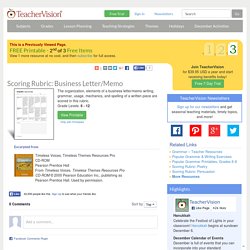
Hanukkah begins at sundown December 6. December Calendar of Events December is full of events that you can incorporate into your standard curriculum. Our Educators' Calendar outlines activities for each event, including: World AIDS Day (12/1), International Volunteer Day (12/6), Hanukkah (begins at sundown 12/6), Handwashing Awareness Week (12/6-12), Computer Science Education Week (12/7-13), Human Rights Day (12/10), Winter Solstice (12/22), Christmas (12/25), Kwanzaa (begins 12/26), Visit the Zoo Day (12/27), and New Year's Eve (12/31).
Plus, celebrate Bingo's Birthday Month, Universal Human Rights Month, and Write to a Friend Month all December long! Socrative. Making Learning Awesome! - Kahoot! QuizStar - Create Online Quizzes. Kathy Schrock\'s Guide for Educators - Teachers Helpers - Assessment & Rubric Information. What Are Some Types of Assessment? In the early theories of learning, it was believed that complex higher-order thinking skills were acquired in small pieces, breaking down learning into a series of prerequisite skills.

After these pieces were memorized, the learner would be able to assemble them into complex understanding and insight -- the puzzle could be arranged to form a coherent picture. Today, we know learning requires that the learner engage in problem-solving to actively build mental models. Knowledge is attained not just by receiving information, but also by interpreting the information and relating it to the learner's knowledge base. What is important, and therefore should be assessed, is the learner's ability to organize, structure, and use information in context to solve complex problems. "Assessment should be deliberately designed to improve and educate student performance, not merely to audit as most school tests currently do. " Classroom Assessment: Student Generated Test Questions. Test-question.
Assessment Tool Lecture: General Purpose Assessment Content Tested: Lecture-Dependent Goals: Develop ability to apply principles and generalizations already learned to new problems and situations Develop appropriate study skills, strategies, and habits Learn terms and facts of this subject Learn concepts and theories in this subject Learn to evaluate methods and materials in this subject Develop a commitment to accurate work Develop ability to perform skillfully.
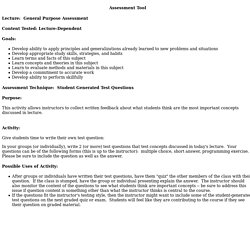
Assess-class-PPT. Quick Assessment Techniques. ClassroomAssessmentTechniquesHopkins. CL-1: Field-tested Learning Assessment Guide (FLAG): CATs: Concept Mapping. Michael Zeilik Department of Physics & Astronomy University of New Mexico "...Lacking resources to implement PSI, I struggled to create a learning environment in a large class of mature students with diverse backgrounds...I was struck at the end of one semester on how little students grasped the big picture of astronomy and how common misconceptions resisted change.
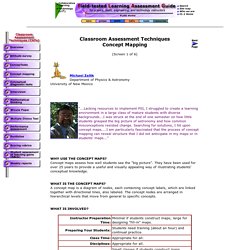
Searching for solutions, I hit upon concept maps....I am particularly fascinated that the process of concept mapping can reveal structure that I did not anticipate in my maps or in students' maps... " WHY USE THE CONCEPT MAPS? Concept maps assess how well students see the "big picture". They have been used for over 25 years to provide a useful and visually appealing way of illustrating students' conceptual knowledge. WHAT IS THE CONCEPT MAPS? Developing Concept Maps. Williams. University Teaching & Learning Center. One sentence summary. One-sentence. Fifty_cats.pdf. Classroom Assessment Strategies. Classroom Assessment Strategies Assumptions of Classroom Assessment Assumption ONE The quality of student learning is directly, although not exclusively, related to the quality of teaching.

Therefore, one of the most promising ways to improve learning is to improve teaching. Assumption TWO To improve their effectiveness, teachers need first to make their goals and objectives explicit and then to get specific, comprehensible feedback on the extent to which they are achieving those goals and objectives. Where are you going? Assumption THREE. Examples of Classroom Assessment Techniques - Faculty Compass - MGH Institute of Health Professions. There are hundreds of variations of classroom assessment techniques.
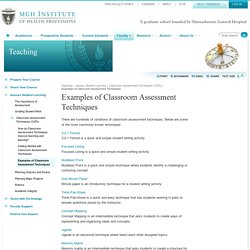
Below are some of the more commonly known techniques: 3-2-1 Format 3-2-1 Format is a quick and simple student writing activity. Focused Listing Focused Listing is a quick and simple student writing activity. Muddiest Point Muddiest Point is a quick and simple technique where students identify a challenging or confusing concept. Background Knowledge Probe - Classroom Assessment Techniques. What Do Students Already Know? Doing so is grounded in learning theories (Ausubel, 1968; Dewey, 1938) and is supported by research on the learning process (Tobias, 1994; Dochy, Segers & Buehl, 1999; Fisher, 2004).

For students, understanding their starting point will make it easier for them to see what they have learned by the end of the course. They can better recall past learning and construct “bridges” between old and new knowledge (Angelo & Cross, 1993). Ambrose, S. A. (2010). Check Student Learning. Lee Haugen [Center for Excellence in Learning and Teaching] Iowa State University February, 1999 What are CATs?
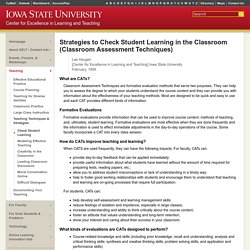
Classroom Assessment Techniques are formative evaluation methods that serve two purposes. They can help you to assess the degree to which your students understand the course content and they can provide you with information about the effectiveness of your teaching methods. Classroom Assessment Techniques: Minute Paper. This page describes the minute paper, one of a series of Classroom Assessment Techniques (CATs) provided by the Field-tested Learning Assessment Guide (FLAG) website.
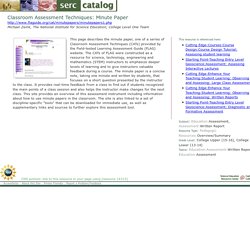
The CATs of FLAG were constructed as a resource for science, technology, engineering and mathematics (STEM) instructors to emphasize deeper levels of learning and to give instructors valuable feedback during a course. The minute paper is a concise note, taking one minute and written by students, that focuses on a short question presented by the instructor to the class. It provides real-time feedback from a class to find out if students recognized the main points of a class session and also helps the instructor make changes for the next class. CL-1: Field-tested Learning Assessment Guide (FLAG): CATs: Minute paper. Michael Zeilik Department of Physics & Astronomy University of New Mexico "When I decided to transform my introductory astronomy course to embrace an integrated conceptual approach, I was vexed by the problem of obtaining immediate classroom assessment.
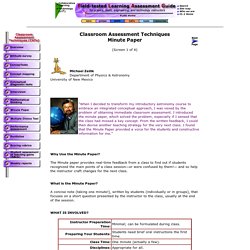
I introduced the minute paper, which solved the problem, especially if I sensed that the class had missed a key concept. From the written feedback, I could then devise another teaching strategy for the very next class. I found that the Minute Paper provided a voice for the students and constructive information for me. " Why Use the Minute Paper? Discussion Three: Muddy Points and Clear Points. Office of Graduate Studies.
Mudcards. Bamuddy.